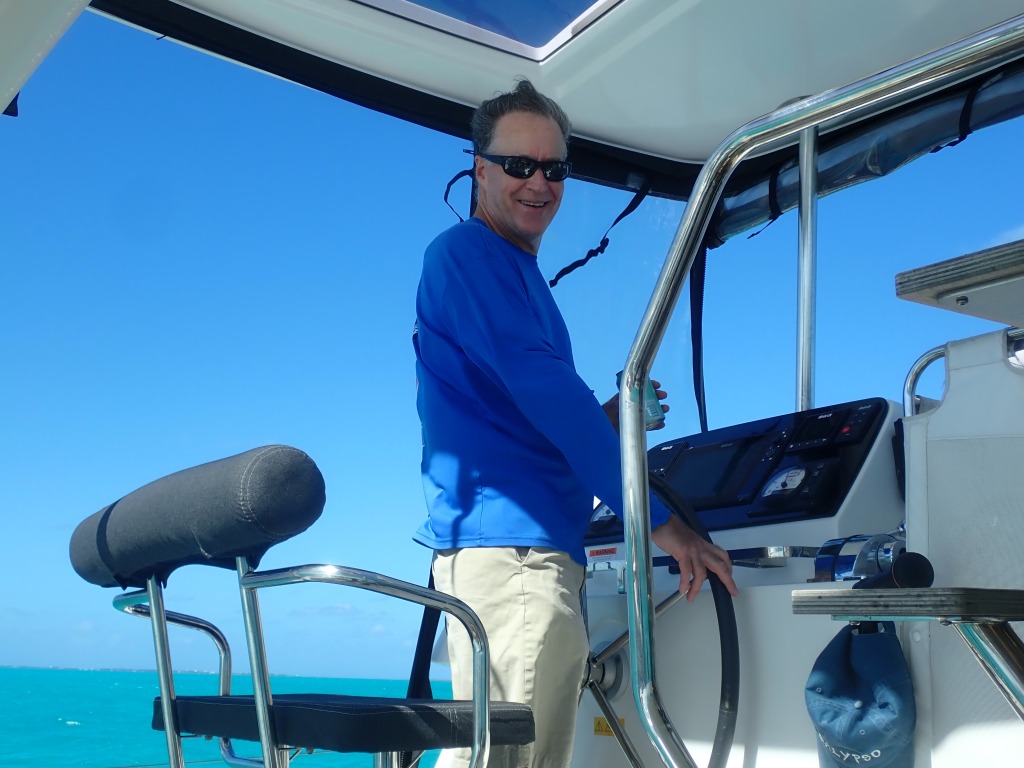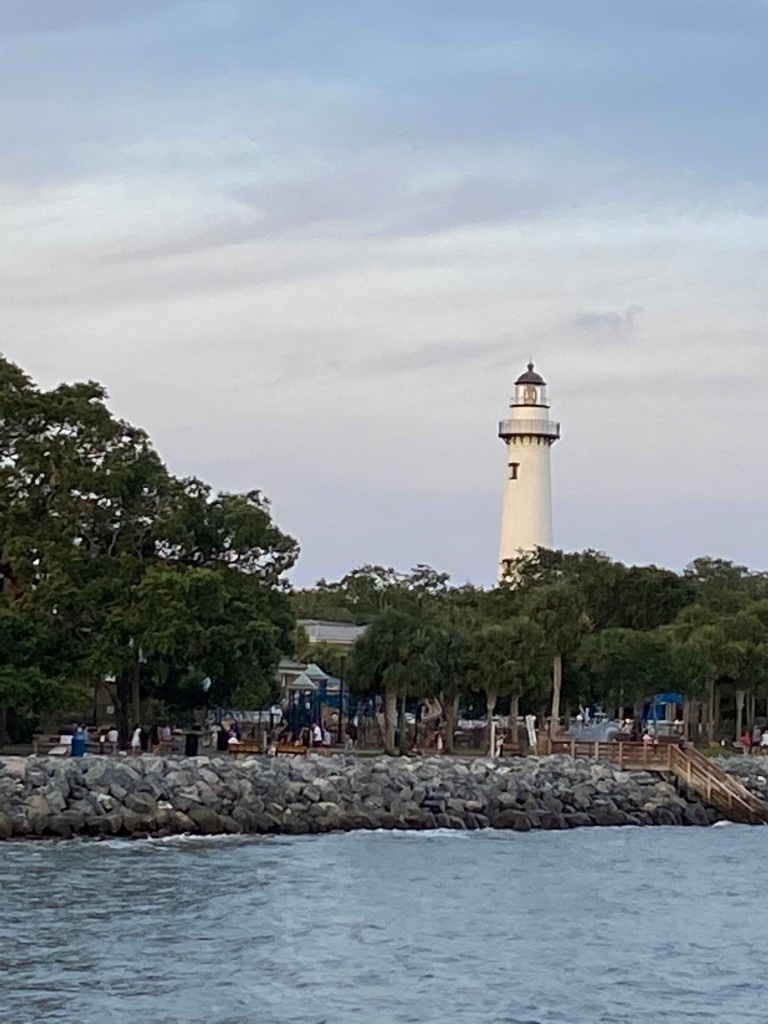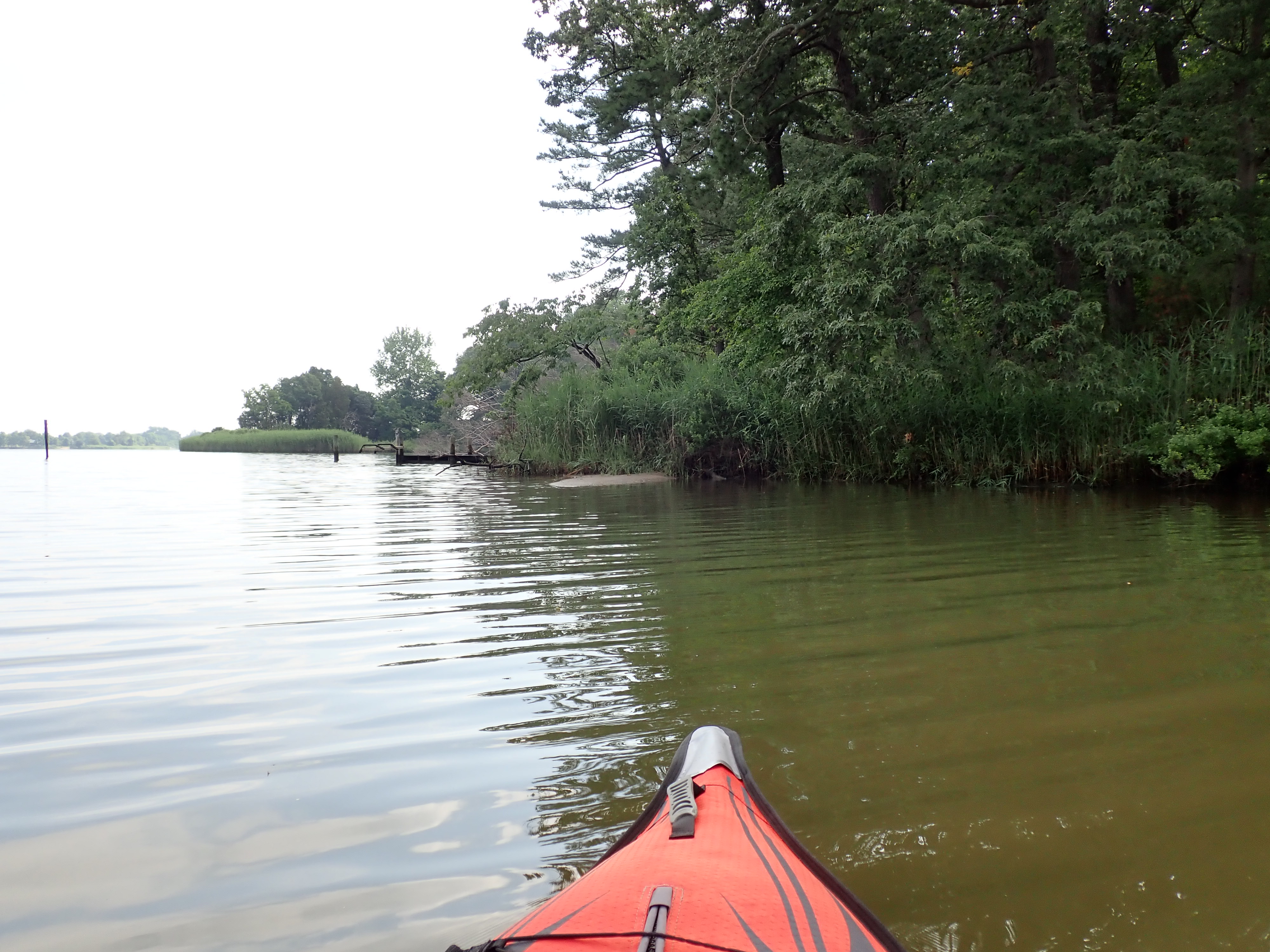
Answering the call of the Sea of Abaco.
You up?
That’s the text I sent my friend Jeff around 1 a.m. very early on a Saturday morning. No, it’s not what you think. It was a response to yet another middle-of-the-night message from American Airlines, with which I have a love-hate relationship. I was supposed to fly to Marsh Harbour (Abaco, Bahamas) that morning, via MIA from DCA. They had cancelled my flight from DCA-MIA, which would cause me to miss the connection to MHH, and kindly rescheduled me for the next day. Jeff was flying the same itinerary, and received the same message from American.
Since we were planning a sailing charter, a missed day would be costly. So we both clacked away on our computers while talking to AA agents and texting each other. Since Jeff was solo, he snagged an earlier flight to MIA on which there was a single seat available. I, on the other hand, spoke fruitlessly (but patiently) with my agent, finding no same-day alternatives. Finally, I just asked him to get me to Nassau (he obliged), and I would take my chances with finding a commuter flight from there to Marsh Harbour.
Who would have ever thought BahamasAir would be the solution? (The running joke is “If you have time to spare, try BahamasAir.”) We added an additional flight to our itinerary (DCA-CLT-NAS-MHH), but the domestic terminal in Nassau isn’t the worst place in the world to transition to Out Island Time. We had a lunch of cracked conch, and after having a Sands Radler, I found my new favorite everyday Bahamian beer: Sands Light.


While a Sands Radler (pink grapefruit added to beer) is delicious and pretty, a Sands Light is a perfect beach beer. Do you suppose they designed the can to match the beach?
Though we arrived hours later than planned (and hours later than our luggage), we finally made it to Marsh Harbour in time for happy hour. Jeff, in the meantime, used his unchaperoned hours in Marsh Harbour productively — he claimed our boat (a Lagoon 42 catamaran named Benedetto), and then befriended the staff and owners of Snappa’s restaurant, which shares the waterfront with the Conch Inn Marina where we were based. After a terrific dinner at the Abaco Beach Resort (walking distance), and a decent night’s sleep, we were ready to face the start day of our charter.

Benedetto on a mooring in Hopetown Harbour.
The start day of a charter is never fun. Between chart and boat briefings and provisioning, it’s tedious work. We divided and conquered, with Rick and Jeff handling the briefings and me handling the hunting and gathering and hauling and stowing.
Not that provisioning is ever easy, but recent charters have left me spoiled. In the British Virgin Islands, and with Nassau as a base for Exumas charters, there are provisioning outfits — sometimes more than one — that let you plan your menus and shopping list at home weeks in advance. Then you transmit your list and magically the groceries are on your boat, sometimes even stowed. Not so in the Abacos these days. I had to hire a taxi and get myself to Maxwell’s and wander the aisles hoping to find what was on my list and making multiple substitutions and menu changes on the fly. (I kept my fingers crossed that one wish list item — key lime pie — would be found in Hopetown.)
We were ready at noon, but, alas, Benedetto was not. Ironically, we’d been upgraded to this Lagoon 42 because the Lagoon 40 we’d originally booked had generator problems; unfortunately, Benedetto was similarly afflicted. Ugh.
All credit to Navigare Yachting for fixing the generator and getting us off the dock by 2 p.m., just 2 hours after we’d expected to. At last, our adventure begins!


Rick and Jeff at the helm station.
It had been nearly 10 years since Rick and I had sailed in the Abacos, and even longer for Jeff, though Rick and I had rented a house in Green Turtle Cay last year. Hurricane Dorian had caused catastrophic damage to the islands in 2019, which were slowly recovering, and we wanted to be part of the recovery. It was hard to see dismasted and destroyed boats, shattered docks, and blacked out buildings, but it was also heartening to see business slowly blooming again.

Our motley crew, on a typical morning. Pop-Tarts and coffee for breakfast, journaling, catching up on life on the “real” world.
Sailing in November is a tricky business. Sometimes the weather is perfect; sometimes it’s dicey. Except for a day or two, we got the dicey weather, but luckily the heavy winds were from the east, so we didn’t need to search for those few anchorages which offered protection from the western cold fronts.
This trip was one of old favorites and new perspectives. Having stayed on land on Elbow Cay in the past, Tahiti Beach (at the south end of the cay) was familiar. But visiting it by boat was new. We found it at low tide, and had it mostly to ourselves, allowing for exploration of what felt like acres of sand flats. Unfortunately, the water was so shallow that we couldn’t really engage in the strenuous sport of Floating: gracelessly sprawling on (or hanging from) an inflated object, with an added degree of difficulty if balancing a beverage.




Tahiti Beach offered us a sandbar playground, almost entirely to ourselves.

Moon rising over Elbow Cay.
While Tahiti Beach looked much as I remembered it, our first stop on Monday, Tilloo Bank, felt different. I have memories of it being a giant swimming pool, crisscrossed by giant stingrays ghosting by. While the stingrays still accompanied us as we floated off the beach, we couldn’t seem to access the swimming pool — whether it had shifted, or we approached it from the wrong direction.


A painted rock tucked in a tree at Tilloo Cay, which we explored by dinghy.
But our next stop, the Bight of Old Robinson (just north of Little Harbour — which we couldn’t visit because the tide was always too low for us to traverse the entrance bar), was everything I dreamed it would be. If you know me, or have read this blog, you know I am obsessed with treasure hunting — and in the Bahamas, I seek sand dollars. I dream about them, I study charts to look for the most likely places to find them, and I comb my memories for spots where I’d found them before. The Bight of Old Robinson is a place I’d found sand dollars before, and hoped to do so again.

An outgoing tide at the Bight of Old Robinson (just north of Little Harbour) provided exploration galore.
Of course, I like to manage expectations as well, so I decide that I will be happy if I simply find a single specimen. Often, spots where we’d found sand dollars before get picked over, or the shifting sands cover them up. It was approaching low tide when we dinghied towards the sand flats and dropped anchor. No sooner had I stepped off the dink did I spot my first sand dollar. And then another and another. I was in heaven! The receding waters were perfect for splashing around, and revealed starfish, jellies, and other critters. We kept exploring, even as it rained on us, until the tide started rising again. We hid for the night in the lee of Lynyard Cay.


In the money!
Expecting rough weather in the coming days, our itinerary had to take that into account. After multiple changes of plan, even as we were underway, we made for Hopetown. With a harbor protected from nearly 360 degrees of wind, mooring balls, and lots (we hoped) to keep us occupied, we could spend days here if necessary, as we have in the past.

The Hopetown lighthouse greets us.

Hopetown’s waterfront.
I’ve long considered Hopetown my “one particular harbor.” See: https://sabrecalypso.wordpress.com/2013/12/19/one-particular-harbour/ As idyllic anchorages go, it’s hard to top. A picturesque lighthouse, a snug harbor, a charming village, and friendly people — residents and visitors alike. By many accounts, Hopetown was the quickest on the route to recovery from Dorian’s ravages; by my reckoning, a great many of the historic cottages in the settlement had survived the storm or were brought back to their former pastel glory.




Hopetown is as colorful and welcoming as ever, including Captain Jack’s.

At Captain Jack’s, with a photobomb by the lighthouse.
Though the sounds of hammering and construction were ever noticeable, many businesses were back in form. We took advantage of that with a lobster salad lunch at Cap’n Jack’s, as well as scoring a coveted key lime pie from Vernon’s Grocery (mission accomplished!)


Have you been to the Abacos if you haven’t had a key lime pie from Vernon’s?
By far, the most sublime swim of the week was on Hopetown’s ocean beach. A quick scramble down the beach access next to St. Matthew’s Church revealed a perfectly sandy shore with gentle surf. I could have stayed forever, and we certainly lingered long enough to become prune-y and thirsty.


Hopetown’s spectacular ocean beach.
Just as we are wont to revisit places that figured in fond memories, there are new spots to discover as well. So while Cap’n Jack’s was our lunch destination, for dinner we cleaned up and went to the fairly swanky Hopetown Inn and Marina — a place new to me. One of our running jokes is that Out Island menus are fairly predictable, usually featuring variations on locally-caught fish (fish fingers, fish burgers), conch (fritters, chowder, curried conch, cracked conch) and occasionally lobster. The restaurant here delivered the expected (and much appreciated) conch chowder, but also preparations of local fish that were unexpected (mahi piccata).

Hopetown Inn and Marina, quiet so early in the season.
Just as I had my wish to find sand dollars, Jeff’s wish was to have Vernon’s key lime pie to commemorate a milestone birthday. So, after dinner, we pointed a fire lighter in the general direction of the pie and celebrated.

Presenting a slice of birthday pie!
The following day delivered on my second wish for this journey: to check out the lagoon north of Scotland Cay (which is just south of Great Guana Cay). I’d seen pictures, but had never been. The worst of the weather held off long enough for us to be able to anchor Benedetto and take the dinghy in. The tide was moving in, allowing us to ride (very deliberately) through the lazy creeks and pools created among the sand flats. The shifting sands and crystal waters are my favorite feature of the Bahamian islands, but alas the wind was picking up and the temperature dropping, so our visit was abbreviated.


Floating in the yummy lagoon north of Scotland Cay.
The deteriorating weather affirmed our decision to stay at a marina for the next couple of nights — Orchid Bay on Great Guana Cay. Being so early in the season, we very nearly had the place to ourselves. Pre-Dorian, this was a full-on resort marina, complete with swimming pool, restaurant and bar. These days, we were happy to have the very secure dock, among the very few in Settlement Harbour which had been repaired. The rest of the harbor was a seascape of splintered pilings and shattered piers.


Safe haven at Orchid Bay.
Orchid Bay is just a short stroll away from the quintessential Abaco institution that is Nipper’s. So early in the season, and on weekdays, Nipper’s was virtually empty. Since we’d visited last year, the main staircase to the beach had been trashed by Hurricane Nicole. Even though there was another way to access the spectacular beach, the conditions were too rough for swimming. Luckily, the conditions are always good for Frozen Nipper’s, and the pool would have to do.




The colorful and welcoming ambience of Nipper’s.

The sea may have looked welcoming, but swimming at Nipper’s was a no-go.
The next day was no better, so we decided to spend another day in the marina. We’ve become spoiled at home by keeping our boats at floating docks. In the Bahamas, though, there are hardly any floating docks, despite a much more significant tidal range. By lunchtime on Thursday, the tide was high and the wind was honking, pushing our cat way above and away from the dock — given that I’d been nursing an Achilles injury from tennis that was worsened by walking through soft sand, there was no getting off Benedetto for me, Despite hoping for a Grabber’s or Nipper’s lunch, we settled instead for a funky clean-out-the-galley lunch aboard.
Later in the afternoon, Rick rigged up a step out of a fender; though still precarious, I was able to climb off the boat. We walked to Grabber’s and found that there was not a soul there. It was clearly open for business, but it was a ghost town. Aw darn … back to Nipper’s. While it was too windy for the pool or the beach, Frozen Nippers, Sands Lights, and conch fritters warmed our souls.
Our last full day delivered weather just as bad as the past couple days’. Being insistent about maintaining a positive attitude, I noted that the wind kept the biting insects away, and that we could all sleep with our hatches open without fear of being eaten. And though it would feel too cold to do much swimming, we did take advantage of one more opportunity to hang out at the north end of Scotland Cay.
We brought Benedetto back to the fuel dock at the charter base in Marsh Harbour and though we arrived before 4 as directed, we were basically abandoned there for the night. In and of itself, this would not have been too bad, except that it started raining and we were just about as far from the shelter of Snappa’s as possible.
Naturally, departure day was perfectly sunny and warm. And travel went off without a hitch.
In the last year, we’ve spent two vacations in the post-Dorian Abacos and one in the post-Irma/Maria BVI. Nature clearly has no mercy. In the BVI, while there remains evidence of damage from the 2017 hurricanes, it seems like much of what has been re-built has been built back to a higher and higher-end (read: more expensive) standard. I have mixed feelings about that, having liked the scruffier charm of the islands in the past, but appreciating some of the pleasures of nicer amenities. 2019’s Dorian wrought devastation in the Abacos, which are slow in returning to their prior glory (though the re-builds seem stronger without becoming more exclusive). We’ve mostly enjoyed the Bahamas Out Islands for their natural beauty and spectacular waters, which remain intact if in slightly edited form. So many residents have left, with no immediate plans to return, so I expect that the Abacos will continue slow recovery.



















































































































































































































































































































































































